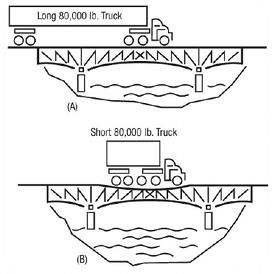Review Questions - Click On The Picture To Begin...

- The distance from the steer axle to the drive axles
- The ratio of the length of the tractor to the length of the trailer
- The distance from the trailer kingpin to the center of the trailer rear axle
- The length of the trailer, regardless of the position of the trailer tandems
Quote From The CDL Manual:
When a combination vehicle makes a low-speed turn - for example a 90-degree turn at an intersection - the wheels of the rearmost trailer axle follow a path several feet inside the path of the tractor steering axle. This is called low-speed offtracking. Excessive low-speed offtracking may make it necessary for the driver to swing wide into adjacent lanes to execute the turn (that is, to avoid climbing the inside curbs or striking fixed objects like telephone poles).
This performance attribute is affected primarily by the distance from the trailer kingpin to the center of the trailer rear axle, otherwise known as the wheelbase of the semitrailer. To prevent trucks from being too long to maneuvering safely around turns encountered in cities and towns, the maximum length allowed from the kingpin to the trailer tandems is set by the individual states.
- The Bridge Formula and the maximum allowed length from Kingpin to trailer tandems.
- The overall gross weight of the vehicle and the maximum percentage of weight on trailer tandems
- The maximum width of 8' 6" on Interstate Highways and the maximum trailer length law
- The tire load rating of the drive axle tires and the minimum clearance law
Quote From The CDL Manual:
- To prevent over-length trucks from becoming a hazard on narrow bridges and tight roadways
- To increase the minimum strength of bridges, allowing for heavier gross vehicle weights which improves efficiency
- To prevent putting too much weight on a relatively small area, causing damage to road surface and bridge structure.
- To prevent overloading the trailer tandems and exceeding the load rating of the trailer tires
Quote From The CDL Manual:
TruckingTruth's Advice:
- To prevent the maximum tire load rating from being exceeded by narrow axle spacing
- To regulate the building of bridge structures so they can support the weight of heavy modern trucks
- To prevent over-width trucks from becoming a hazard on narrow bridges
- To limit the weight-to-length ratio of a vehicle crossing a bridge.
Quote From The CDL Manual:
- When taking off from a dead stop, the initial torque of the engine on the drivetrain will cause a slight offtracking of the tractor which could be a hazard to other traffic
- When making a high speed turn, the momentum carried by the trailer will cause it to swing wide and possibly outside the lane of travel
- When a combination vehicle makes a low-speed turn the wheels of the rearmost trailer axle follow a path several feet inside the path of the tractor steering axle.
- When a trailer's tandem axles are slightly out of alignment, the rear of the trailer will track off to one side or another instead of directly behind the tractor









 TT On Facebook
TT On Facebook